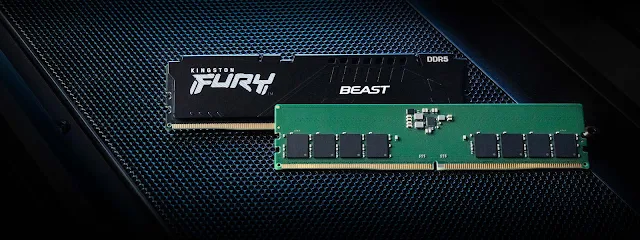Double Data Rate 5 Synchronous Dynamic Random-Access Memory (DDR5 SDRAM) is a new type of synchronous dynamic random-access memory, which was designed to reduce power consumption and double bandwidth compared to its predecessor, DDR4 SDRAM. The standard, which was originally planned for 2018, was released on July 14, 2020, and it promises a significant improvement in memory performance for various applications. DDR5 introduces several new features, such as Decision Feedback Equalization (DFE) and on-board voltage regulators, which enable higher bandwidth and lower power consumption.
One of the main advantages of DDR5 over DDR4 is its increased bandwidth. DDR5 can provide up to 4.8 gigabits per second (Gbps) of bandwidth, which is twice the bandwidth offered by DDR4. This increased bandwidth enables faster data transfer rates, which is particularly important for applications that require large amounts of data to be processed quickly, such as artificial intelligence, machine learning, and high-performance computing. DDR5 also supports more memory channels per module than DDR4, which further enhances memory bandwidth.
Another key feature of DDR5 is its support for Decision Feedback Equalization (DFE), which is a signal processing technique that helps to mitigate signal degradation in high-speed memory interfaces. DFE enables I/O speed scalability, which means that DDR5 can support higher speeds without sacrificing signal integrity. This is particularly important for applications that require high-bandwidth memory, such as graphics-intensive gaming, video editing, and scientific simulations.
DDR5 also has lower power consumption than DDR4. DDR5 reduces the memory voltage to 1.1 volts, which is lower than the voltage used by DDR4. This reduction in voltage translates into lower power consumption, which is particularly important for battery-powered devices, such as laptops and smartphones. DDR5 also incorporates on-board voltage regulators, which enable higher speeds and lower power consumption by providing a stable voltage supply to the memory.
DDR5 has the same latency as DDR4 and DDR3, which means that it takes the same amount of time to access data stored in memory. However, DDR5 has higher frequencies than DDR4, which enables faster data transfer rates. DDR5 also supports a larger maximum DIMM capacity than DDR4, with a maximum capacity of 512 GB per module. This means that DDR5 can support more memory-intensive applications, such as large-scale virtualization and data analytics.
Several companies have already announced the development of DDR5 memory modules. Rambus announced a working DDR5 DIMM in September 2017, and SK Hynix announced completion of its first DDR5 RAM chip in November 2018, running at 5200 MT/s at 1.1 V. In February 2019, SK Hynix announced a 6400 MT/s chip, the highest speed specified by the preliminary DDR5 standard. Samsung also revealed a 512 GB 7200 MT/s RAM DIMM in August 2021, which is the highest-capacity DDR5 memory module announced to date.
In conclusion, DDR5 SDRAM is a new type of memory that promises significant improvements in memory performance for various applications. DDR5 introduces several new features, such as Decision Feedback Equalization (DFE) and on-board voltage regulators, which enable higher bandwidth and lower power consumption. DDR5 also supports more memory channels per module than DDR4, which further enhances memory bandwidth. DDR5 is expected to replace DDR4 in most use-cases, as it offers better performance and lower power consumption. The development of DDR5 is an important milestone in the evolution of memory technology, and it opens up new possibilities for the development of high-performance computing systems.

